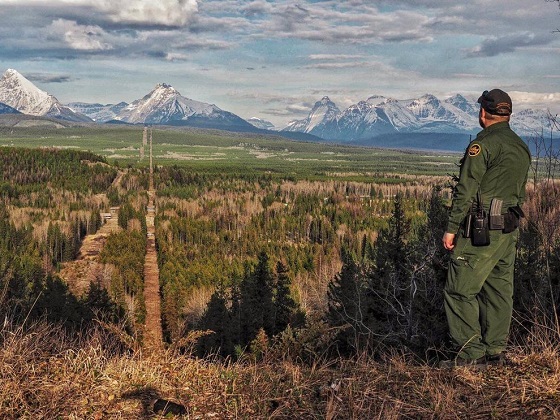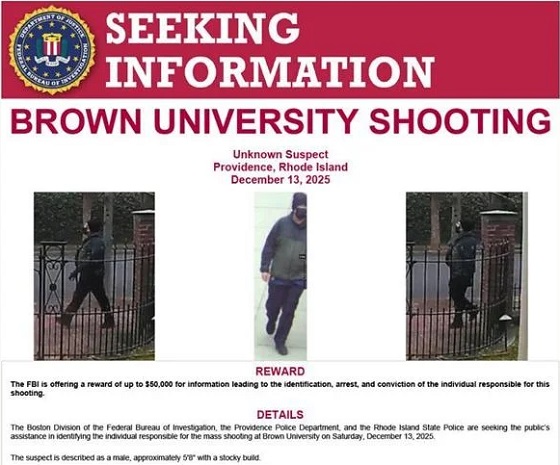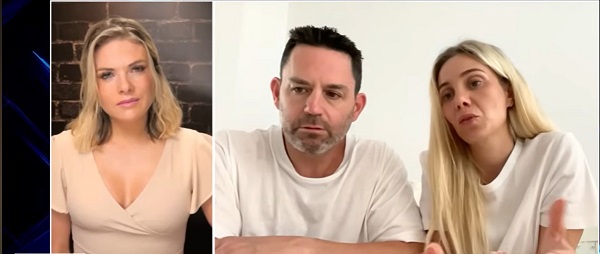Crime
The US Canadian border: Greatest number of terrorist watch list individuals being apprehended at northern border

A Border Patrol agent standing watch at the Montana-Canada border in the CBP Spokane Sector. The Spokane Sector covers the U.S.-Canada border along the northwestern section of Montana, part of Idaho, and the eastern part of Washington.
From The Center Square
Lack of operational control at northern border poses national security threats
The northern border largely has been unmanned and understaffed for decades as federal reports issue conflicting conclusions about how much, or how little, operational control exists.
Some officials have suggested the U.S. Department of Homeland Security has just 1% operational control over the northern border after a 2019 General Accounting Office audit of U.S. Customs and Border northern border operations. But a December 2022 DHS report claimed, “The Border Patrol is better staffed today than at any time in its 87-year history,” noting no surveillance of extensive parts of the northern border existed prior to 9/11.
After 9/11, several federal agencies were combined to fall under the newly created Department of Homeland Security. Within 20 years, roughly 950 miles along the U.S.-Canada border from Washington to Minnesota, and roughly 200 miles along the northern border in New York and Lake Ontario, were under unmanned aircraft surveillance. None of these areas “were covered prior to the creation of DHS,” DHS says, meaning the northern border was largely unprotected since Border Patrol’s founding in 1924.
In 2012, DHS released its first unified department strategy for U.S.-Canada border security, prioritizing “deterring and preventing terrorism and smuggling, trafficking, and illegal immigration; safeguarding and encouraging the efficient flow of lawful trade, travel, and immigration; and, ensuring community resiliency before, during, and after terrorist attacks and other disasters.”
Within 10 years at the northern border, more than 2,200 Border Patrol agents were stationed between ports of entry; nearly 3,700 CBP officers were stationed at ports of entry; more than 35 land ports of entry were modernized; and thermal camera systems, mobile and remote video surveillance systems had been deployed.
Havre Sector Border Patrol agent patrolling northern border on an ATV. The Havre Sector covers the U.S.-Canada border along most of Montana’s northern border, and includes part of Idaho and all of Wyoming, Colorado and Utah.
Despite these improvements, “the northern border is under-resourced by far compared to the southwest border,” former Border Patrol chief Mark Morgan told The Center Square. “But at the same time, it still represents significant threats. Cartels are expanding their operations, flying people into Canada, which doesn’t require a visa, presenting an opportunity for terrorist watch-listed individuals to exploit. It’s much easier to get to Canada to come across.”
“Data from 39 months shows terrorist watch-listed individuals are coming here every day and they aren’t stopping,” Morgan added.
For years and prior to the current border crisis, there weren’t enough personnel to cover all shifts, and the infrastructure, technology and equipment afforded to them didn’t compare to those at the southwest border, he said. People can easily drive snow mobiles over frozen territory or boats across the Great Lakes in areas that are unmanned, Morgan said, with a previous policy of self-reporting to authorities.
“The northern border represents a threat,” Morgan said. Noting it only took 19 men to carry out the 9/11 terrorist attacks, Morgan has warned that a terrorist threat is already in the U.S. No one knows how many terrorist watch-listed individuals have illegally entered who weren’t caught, multiple officials have told The Center Square.
While much attention has focused on the southwest border, the greatest number of known or suspected terrorists to ever be apprehended in U.S. history were at the northern border in fiscal 2023, breaking fiscal 2022’s record, The Center Square first reported.
This fiscal year through April, the greatest number of KSTs (known or suspected terrorists) continue to be apprehended at the northern border, 143 so far, according to CBP data.
Potential terrorist threats are not new and have persisted for some time, federal reports indicate. One Border Patrol intelligence report says terrorist threats potentially come from “foreign violent extremists to exploit established alien smuggling routes and networks for the purpose of evading detection en route to the United States.”
Other threats include drug smuggling from Canada into the U.S., connected to “criminal groups with known ties to or hired by Mexican drug trafficking organizations” and human smuggling. In the last few years, human smuggling attempts and apprehensions have significantly increased, The Center Square has reported.
The Center Square first began reporting on northern border national security threats several years ago. Since then, apprehensions of illegal border crossers in the first six months of fiscal 2024 were the highest on record. In the busiest sector of Swanton, Border Patrol agents recently apprehended more people in one week than they did in all of fiscal 2021.
Last month, they apprehended more than 1,400 illegal border crossers, more than they did in fiscal years 2021 and 2022 combined, Swanton Sector Chief Border Patrol Agent Robert Garcia just announced, saying it was “another record-breaking milestone in northern border history.”
This is after they apprehended more than 6,700 in fiscal 2023, more than the apprehensions of the previous 11 years combined, The Center Square first reported.
The U.S.-Canada border is the longest international border in the world of 5,525 miles. Unlike the U.S.-Mexico border, there are no border walls or similar barriers along the U.S.-Canada border. Through DHS, CBP officers are tasked with border security at ports of entry and Border Patrol agents between ports of entry along 4,000 miles. The U.S. Coast Guard, working with CBP’s Air and Maritime Operations, covers maritime security.
Crime
Brown University shooter dead of apparent self-inflicted gunshot wound

From The Center Square
By
Rhode Island officials said the suspected gunman in the Brown University mass shooting has been found dead of an apparent self-inflicted gunshot wound, more than 50 miles away in a storage facility in southern New Hampshire.
The shooter was identified as Claudio Manuel Neves-Valente, a 48-year-old Brown student and Portuguese national. Neves-Valente was found dead with a satchel containing two firearms inside in the storage facility, authorities said.
“He took his own life tonight,” Providence police chief Oscar Perez said at a press conference, noting that local, state and federal law officials spent days poring over video evidence, license plate data and hundreds of investigative tips in pursuit of the suspect.
Perez credited cooperation between federal state and local law enforcement officials, as well as the Providence community, which he said provided the video evidence needed to help authorities crack the case.
“The community stepped up,” he said. “It was all about groundwork, public assistance, interviews with individuals, and good old fashioned policing.”
Rhode Island Attorney General Peter Neronha said the “person of interest” identified by private videos contacted authorities on Wednesday and provided information that led to his whereabouts.
“He blew the case right open, blew it open,” Neronha said. “That person led us to the car, which led us to the name, which led us to the photograph of that individual.”
“And that’s how these cases sometimes go,” he said. “You can feel like you’re not making a lot of progress. You can feel like you’re chasing leaves and they don’t work out. But the team keeps going.”
The discovery of the suspect’s body caps an intense six-day manhunt spanning several New England states, which put communities from Providence to southern New Hampshire on edge.
“We got him,” FBI special agent in charge for Boston Ted Docks said at Thursday night’s briefing. “Even though the suspect was found dead tonight our work is not done. There are many questions that need to be answered.”
He said the FBI deployed around 500 agents to assist local authorities in the investigation, in addition to offering a $50,000 reward. He says that officials are still looking into the suspect’s motive.
Two students were killed and nine others were injured in the Brown University shooting Saturday, which happened when an undetected gunman entered the Barus and Holley building on campus, where students were taking exams before the holiday break. Providence authorities briefly detained a person in the shooting earlier in the week, but then released them.
Investigators said they are also examining the possibility that the Brown case is connected to the killing of a Massachusetts Institute of Technology professor in his hometown.
An unidentified gunman shot MIT professor Nuno Loureiro multiple times inside his home in Brookline, about 50 miles north of Providence, according to authorities. He died at a local hospital on Tuesday.
Leah Foley, U.S. attorney for Massachusetts, was expected to hold a news briefing late Thursday night to discuss the connection with the MIT shooting.
Crime
Bondi Beach Survivor Says Cops Prevented Her From Fighting Back Against Terrorists


From the Daily Caller News Foundation
A woman who survived the Hanukkah terrorist attack at Bondi Beach in Australia said on Monday that police officers seemed less concerned about stopping the attack than they were about keeping her from fighting back.
A father and son of Pakistani descent opened fire on a Hanukkah celebration Sunday, killing at least 15 people and wounding 40, with one being slain on the scene by police and the other wounded and taken into custody. Vanessa Miller told Erin Molan about being separated from her three-year-old daughter during Monday’s episode of the “Erin Molan Show.”
“I tried to grab one of their guns,” Miller said. “Another one grabbed me and said ‘no.’ These men, these police officers, they know who I am. I hope they are hearing this. You are weak. You could have saved so many more people’s lives. They were just standing there, listening and watching this all happen, holding me back.”
Dear Readers:
As a nonprofit, we are dependent on the generosity of our readers.
Please consider making a small donation of any amount here.
Thank you!
WATCH:
“Two police officers,” Miller continued. “Where were the others? Not there. Nobody was there.”
New South Wales Minister of Police Yasmin Catley did not immediately respond to a request for comment from the Daily Caller News Foundation about Miller’s comments.
Australian Prime Minister Anthony Albanese vowed to enact further restrictions on guns in response to the attack at Bondi Beach, according to the Associated Press. The new restrictions would include a limit on how many firearms a person could own, more review of gun licenses, limiting the licenses to Australian citizens and “additional use of criminal intelligence” to determine if a license to own a firearm should be granted.
Sajid Akram, 50, and Naveed Akram, 24, reportedly went to the Philippines, where they received training prior to carrying out the Sunday attack, according to the Australian Broadcasting Corporation. Naveed Akram’s vehicle reportedly had homemade ISIS flags inside it.
Australia passed legislation that required owners of semi-automatic firearms and certain pump-action firearms to surrender them in a mandatory “buyback” following a 1996 mass shooting in Port Arthur, Tasmania, that killed 35 people and wounded 23 others. Despite the legislation, one of the gunmen who carried out the attack appeared to use a pump-action shotgun with an extended magazine.
-

 Automotive13 hours ago
Automotive13 hours agoPoliticians should be honest about environmental pros and cons of electric vehicles
-

 Agriculture2 days ago
Agriculture2 days agoWhy is Canada paying for dairy ‘losses’ during a boom?
-

 Business2 days ago
Business2 days agoCanada Hits the Brakes on Population
-

 Daily Caller2 days ago
Daily Caller2 days ago‘Almost Sounds Made Up’: Jeffrey Epstein Was Bill Clinton Plus-One At Moroccan King’s Wedding, Per Report
-

 Crime2 days ago
Crime2 days agoBrown University shooter dead of apparent self-inflicted gunshot wound
-

 Business2 days ago
Business2 days agoTrump signs order reclassifying marijuana as Schedule III drug
-

 Bruce Dowbiggin24 hours ago
Bruce Dowbiggin24 hours agoHunting Poilievre Covers For Upcoming Demographic Collapse After Boomers
-

 Alberta1 day ago
Alberta1 day agoAlberta’s new diagnostic policy appears to meet standard for Canada Health Act compliance






